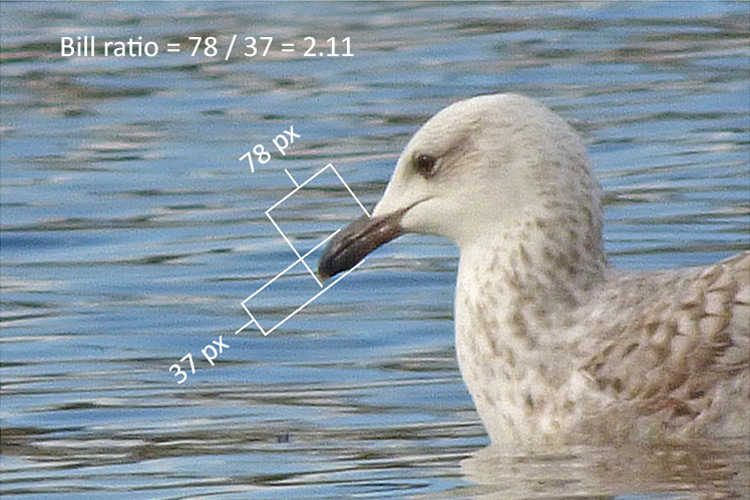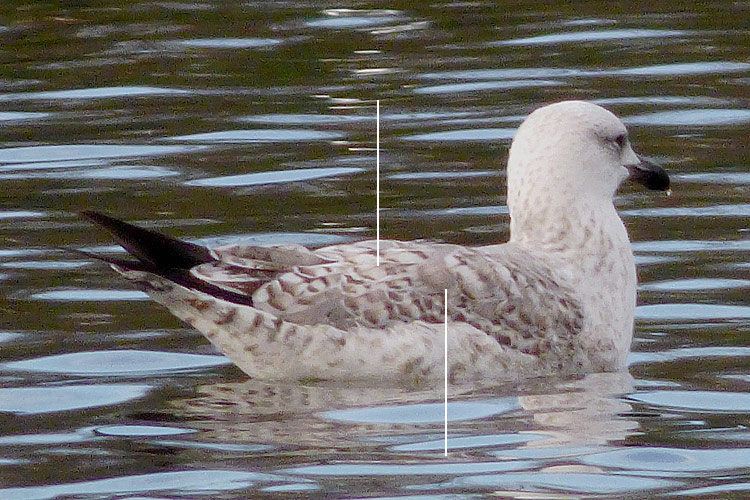LWHG at Moseley, West Midlands, February 2017 |
A second calendar-year (1W) gull which frequented Swanshurst Park, at Moseley, West Midlands, during February 2017 proved to be an exemplar of controversial LWHGs. Opinions were divided between Caspian Gull and Yellow-legged Gull and, in the field, the appearance did vary quite extensively, depending upon posture and even which side of the bird was in view. The images below illustrate this variability and discuss particular traits. An evident gonys and relatively coarse marks in some feather tracts did accord better with Yellow-legged Gull and it is easy to understand why adherents were drawn to this diagnosis. However, several features were not typical of YLG. In combination, this produced a character which justifiably raised questions and led some to favour Caspian Gull. Yet, in the field, the gull certainly did not match the 'classic' Caspian Gull image. However, 'classic' individuals are, in truth, the 'most distinctive' and not necessarily the 'most typical'. The popular image of Caspian Gull is something of a caricature (most casual sketches of the species, for example, depict a wholly exaggerated bill ratio (length : depth) -see below). Any individual which does not match this overstated (or at least 'exceptional') appearance inevitably shifts its demeanour towards that of its congeners. Equally, the head-shape, bill-ratio, the pattern of certain second-generation scapulars and the underwing pattern were all offset from those of a typical YLG. Many of these features were within the range of variation of both species. As well as individual variability among Caspian and Yellow-legged Gulls, the issue of hybrids besets all LWHGs which are not 'classic'. I have adopted a cautious approach and the Moseley gull is included here in the section on gulls of uncertain identity.

© A. R. Dean
Plate 1. Here the neck is neither unduly extended nor settled into
the shoulders and the posture appears relaxed.
The head appears proportionately small and has a slightly pear-shaped outline,
with somewhat extruded
maxillary feathering leading into a quite pointed-looking bill. The eye is
set well forward and close to the forehead.

© A. R. Dean
Plate 2. This plate illustrates the technique for measuring
bill-ratio, as employed in the key paper on Caspian Gull identification
by
Chris Gibbins et al (see References).
Here the bill ratio is 2.11 while the mean measured from several photos was
2.15.
This is low for Caspian Gull, where Appendix 1 in Gibbins et al.
indicates a mean for 1W of c. 2.55 with SD of 0.25.
Conversely, a value of
2.15 is high for YLG, which has a mean of c. 1.90 with SD of 0.15 (own data).
Thus, the Moseley gull
has a ratio very much 'in between'.

© A. R. Dean
Plate 3. Here the head is settled more towards the shoulders, with
the neck compressed. The head appears proportionately larger
and slightly
more bulbous.
The bill shows
an evident gonys. With the left-side in view, the upperparts appear quite
coarsely marked,
with some
second-generation scapulars
showing broad, almost triangular, interior marks and a 'double barred'
pattern.
The under tail coverts are quite coarsely marked.
When the gull was standing on the embankment,
retained central
greater-coverts revealed a barred / notched pattern.

© A. R. Dean
Plate 4. On the right side, the second-generation scapulars were
less-heavily marked, with several feathers showing
a subterminal anchor
and a fine mesial streak but extensive and 'clean' areas of grey
basally.

© Graham Fellows
Plate 5. The inner primaries show grey on inner webs reaching the
edge of the wing, creating a 'venetian blind' pattern.
There are pale 'lozenges' at the extremities of the inner webs. The outer
webs are dark but have pale lines internally.
The underwing shows a pale and relatively plain centre and the underside of
the primaries is also pale.
In combination, this produces a rather 'hollowed out' appearance
overall. The tail has a black terminal band
of quite even but unexceptional depth and has black 'spots' internally, The
bases of the outer feathers are more-cleanly white.
The features described in the captions send 'mixed messages' in several respects. The barred greater coverts and under tail coverts tend to favour Yellow-legged Gull. Aspects of the head shape-and-size and the underwing recall Caspian Gull.. The 'venetian blind' and 'lozenge' patterns of the inner primaries are said to favour Caspian but the pale internal lines on the outer webs may be more frequent in Yellow-legged. Coarse cross-bars on second-generation scapulars are deemed to favour Yellow-legged while the plainer more-extensively pale grey feathers are associated with Caspian. The width of the tail-band better matches Caspian but the interior pattern favours Yellow-legged. The evident gonys is a YLG trait. Significantly, the bill-ratio -which is a key discriminant - is not typical of either taxon but sits somewhere in-between. It is very easy to be selective when arguing the case for a particular identification and also to place undue emphasis on individual traits rather than assessing them in combination. A plethora of photos of first and second calendar year Caspian Gulls and Yellow-legged Gulls is available on the Gull Research Organisation website. Even a cursory examination there shows that, in practice, most of the features noted in the captions above are no more than 'percentage' features. There is wide variation, and overlap between YLG and Caspian, in the scapular pattern, the pattern of the inner primaries, the underwing pattern and the tail-pattern, for example. Most of the cited characters are within the range of variation of both species. It is unwise to be dogmatic about the identity of an individual when several features are less than ideal. The character of both Yellow-legged Gull and Caspian Gull derives from a combination of features and is more than 'the sum of its parts'. A forensic analysis will often fail to provide a convincing diagnosis.
The problems arising from character variation and convergence are exacerbated by the issue of hybridization, which besets LWHGs more than any other group of birds. Part 2 of the paper by Chris Gibbins et al was dedicated to the issue of hybrids and the paper developed a 'scoring system' by which a 'hybrid index' could be calculated from a combination of traits. However, this applied to hybrids between Caspian Gull and Herring Gull (hitherto the most common source of problems) and most of the trait-scoring system does not apply to 1W Caspian versus Yellow-legged - where many features are much more convergent. More recently, hybridization between Caspian Gull and Yellow-legged Gull has been on the increase in central Europe. See details in Neubauer et al. (2010) - where plate 216, showing a hybrid 1W Caspian x Yellow-legged Gull, is also instructive. Thus, the identity of the Moseley gull is not of necessity a straight choice between Yellow-legged Gull and Caspian Gull. The possibility of hybrid origin also needs to be 'in the frame'. To my eye, even after extensive observation in the field, the appearance of the Moseley gull did not 'resonate' convincingly as either Yellow-legged Gull or Caspian Gull.
I asked Chris Gibbins for his opinion and his response follows:
'This is a tricky bird.
It is not a classical Caspian, but you know this. That said, plumage wise I have seen many birds matching this in e.g. Romania, Georgia. Some can have heads streaked like this so on its own this is not a problem. Such a head goes hand in hand with more advanced moult, which we see on this bird; so thatís fine. The rest of the plumage looks acceptable for Caspian too (e.g. inner primaries). The problem is the bill. I would suggest that the general structure of the bird is more like a female. Females obviously tend to have smaller bills that can look very weak, slender and contourless Ė but this bird has a very strong gonys. It has a strong angle and bulges. This I find most odd for a female. Perhaps in Romania or Ukraine or around the Caspian I would forgive this anomaly, but in UK then itís a different matter.
I was at the IGM [International Gull Meeting] in Germany last spring and we visited several colony areas with mixed pairs. It is really alarming what is happening there; Herrings, Caspians and YLGs all together and all combinations involved in mixed pairs. Many of the birds we were seeing were birds that were outwith my experience of Caspians from Azerbaijan, Ukraine etc where Iíve visited breeding colonies, but nor could I fit them comfortably into Herring or YLG. A high % of assumed hybrids. It was fascinating but very alarming. So personally Iíd be cautious with birds like this.
Of course you have to counter this with acceptance that, like all gulls, Caspian vary a lot, but we have to find some sort of pragmatic dividing line. I think a bill like this on an out-of-range bird is perhaps just on the wrong side of the line to be considered a failsafe Caspian. The fact that you guys are debating it tells you a lot about what you need to know.'
Thus, although approaching the issue from a Caspian baseline, Chris Gibbins too sees 'mixed messages' in the appearance of the Moseley gull and counsels 'caution' in attributing it to a given taxon. Such gulls will always divide opinion. Many problematic gulls are debated on internet discussion groups, particularly on the American 'Id-Frontiers' site. Few discussions achieve unanimity of opinion. My own conclusion is that the Moseley gull is an example where a firm identification may well be unachievable..... That's LWHGs.
Thanks to Graham Fellows for his photos showing the wing and tail patterns and to Chris Gibbins for his informative comments.
|
|
|
|
Home |
Mediterranean
| Laughing |
Franklin's |
Little |
Sabine's |
Bonaparte's |
Black-headed |
Ring-billed | Common |
Lesser Black-backed | |